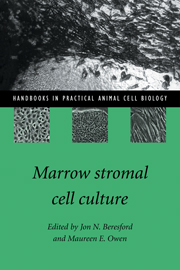Book contents
- Frontmatter
- Contents
- List of contributors
- Preface to the series
- Preface
- 1 The marrow stromal cell system
- 2 The bone marrow stroma in vivo: ontogeny, structure, cellular composition and changes in disease
- 3 Isolation, purification and in vitro manipulation of human bone marrow stromal precursor cells
- 4 Isolation and culture of human bone-derived cells
- 5 Marrow stromal adipocytes
- 6 Osteoblast lineage in experimental animals
- 7 Chondrocyte culture
- 8 Osteogenic potential of vascular pericytes
- Index
4 - Isolation and culture of human bone-derived cells
Published online by Cambridge University Press: 20 January 2010
- Frontmatter
- Contents
- List of contributors
- Preface to the series
- Preface
- 1 The marrow stromal cell system
- 2 The bone marrow stroma in vivo: ontogeny, structure, cellular composition and changes in disease
- 3 Isolation, purification and in vitro manipulation of human bone marrow stromal precursor cells
- 4 Isolation and culture of human bone-derived cells
- 5 Marrow stromal adipocytes
- 6 Osteoblast lineage in experimental animals
- 7 Chondrocyte culture
- 8 Osteogenic potential of vascular pericytes
- Index
Summary
Introduction
Cells of the osteoblast lineage are essential for the normal growth, development and maintenance of the vertebrate skeleton. They are responsible for bone formation, participate in the regulation of bone resorption and contribute to the maintenance of the haematopoietic microenvironment. The term ‘osteoblast’ refers to a relatively short-lived cell that is found in vivo in direct apposition to a newly forming bone surface and one which is actively engaged in the synthesis and secretion of a collagen-rich extracellular matrix (osteoid). In histology texts osteoblasts are frequently described as plump, basophilic cells that are obviously polarised and, as befits their function, possess a well-developed golgi apparatus and endoplasmic reticulum.
It is important to appreciate that osteoblasts are not terminally differentiated cells. During the process of bone formation, a proportion of osteoblasts become entrapped within the bone matrix and develop long, cellular processes that enable them to make contact with other cells; these are referred to as osteocytes and they are the most abundant cell type present in adult human bone. Of the remaining cells, the majority are destined to die, by a mechanism that is morphologically inconspicuous and therefore bears the hallmark of apoptosis. A minority of osteoblasts cease their biosynthetic activities, develop a flattened, elongated morphology and persist as bone lining cells (Parfitt, 1990).
Much of our knowledge of the biology of cells of the osteoblast lineage is based on studies using fetal or neonatal tissue from experimental animals, which is poorly mineralised and highly cellular when compared with adult bone.
- Type
- Chapter
- Information
- Marrow Stromal Cell Culture , pp. 43 - 66Publisher: Cambridge University PressPrint publication year: 1998
- 22
- Cited by



